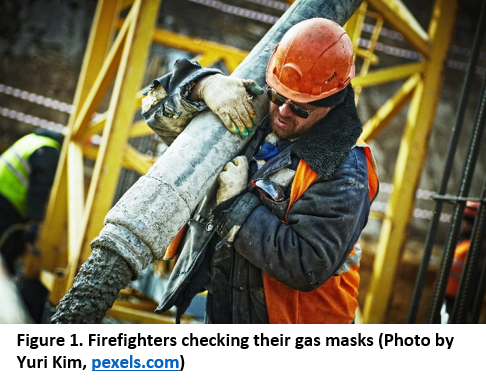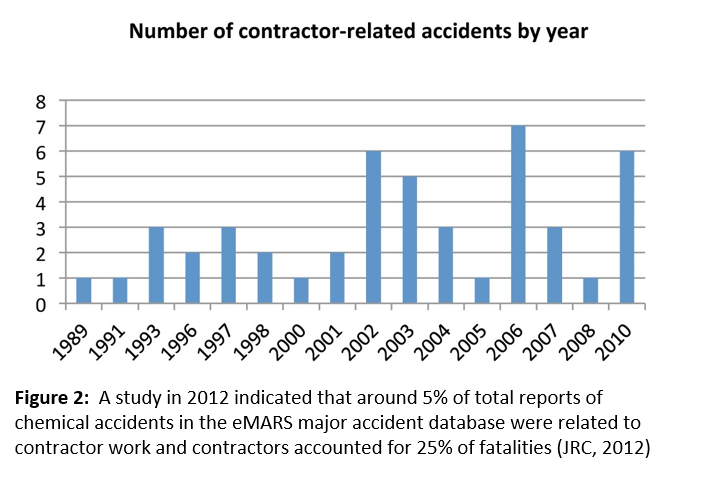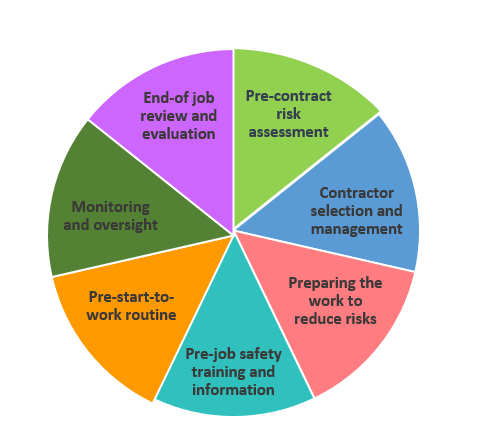Link to pdf
Link to Seveso Inspection Series Home Page
CIC - Management of Contractors
Definition and scope - Contractors working on hazardous sites - Contractors exposure to chemical hazards - Contractors and impact on risk control - Elements of a contractor risk management programme - Potential checklist questions (pdf)
Publication of Common Inspection Criteria is intended to share knowledge about technical measures and enforcement practices related to major hazard control and implementation of the Seveso Directive. The criteria have been developed by Seveso inspectors to aid in dissemination of good enforcement and risk management practices for the control of major industrial hazards in Europe and elsewhere. This particular issue highlights a number of issues that are critical for successfully reducing risks through efficient and correct training and follow up of contractors and subcontractors. Insufficient follow up and training can lead to dangerous situations or accidents. Many major accidents and incidents involve (sub)contractors. Note that this document is not intended as a technical standard nor as a summary or replacement of any existing standards on the matter.
DEFINITION AND SCOPE
This document provides common inspection criteria to guide inspectors to assess the Seveso companies system for selection and management of contractors. The role of Seveso inspectors is to verify that the operator is managing correctly the risks involved in using contractors. Specifically, this document supports the inspector in verifying that the operator has fulfilled the responsibility to contractors consistent with Article 5 of the Seveso Directive (“to take all necessary measures to prevent major accidents and to limit their consequences for human health and the environment”).
|
Contractors in this document can be understood as a company hired in by a Seveso establishment to perform work in the establishment on a contract basis.
A subcontractor is a type of contractor. Subcontractors also work on a contractual basis, and they also offer a particular set of skills which they perform for customers. The key point about subcontractors is that they form agreements with the contractor, not with the customer.
The company can hire contractors for all kinds of assignments; however, the scope of this document is mainly physical tasks in the installations mentioned below:
- Installation of new equipment
- Maintenance and repair
- Housekeeping (cleaning and painting)
- Inspection of equipment
- Transportation
- Security
|
 |
Contractors work for themselves have their own employees and offer a particular suite of skills. The terms contractor and subcontractor are sometimes used interchangeably. While it is important to understand the few key differences between the two roles, these two classes of employees generally work together to complete projects effectively. As such, both contractors and subcontractors are within the scope of this document since they are regarded as external personnel at the Seveso plant. Therefore, the term contractors is an umbrella term covering both contractors and subcontractors in this document.
Outsourcing is when all activities of a certain type in a Seveso-establishment is performed by an external company. Such activities can include, for example, all maintenance of the plant or external emergency preparedness and response, and should also be covered by the term contractors.
It is standard practice for an establishment's safety management system to include procedures for selecting and managing contractors. This document highlights the impact of risk due to the use of contractors and offers suggestions on how an inspector can verify that sufficient measures are in place on a hazardous site to manage these risks. The document focuses primarily on contractors that are hired for a specific job during a specific limited duration of time, and not those that are present on the site on a permanent basis.

|
CONTRACTORS WORKING ON HAZARDOUS SITES
There are several reasons why a Seveso establishment may decide to use a contractor to accomplish work at the site. One common reason is the need for specific types of skills for specific jobs, combined with a need to reduce costs and maintain flexibility in the work force. Specialist skills cover a wide range of competences, including pipefitters, welders, electricians, construction workers, metallurgists, equipment specialists, etc. Depending on the need, contractors can be hired to perform everyday tasks, or for jobs that are required only at certain intervals, e.g., once a month or every year. Some types of work, e.g. new construction, may take place just once or at irregular intervals. Duration of jobs performed by contractors can also vary. An equipment repair might take a day, but a refinery maintenance turnaround might take weeks and new construction could take months.
|
|
CONTRACTOR EXPOSURE TO CHEMICAL HAZARDS
Contractors are well represented in statistics on fatalities and injuries from chemical accidents For example, a study of data reported to the EU’s eMARS data calculated that contractors accounted for around 25% of 266 fatalities reported in 847 major chemical accidents from 1989 to 2010 (MAHB, 2012) (see Figure 2). In several cases, the root causes of these accidents were not connected to the fault of the contractors, but they were the victims because they were the closest to the chemical release. Chemical accidents involving contractors very often happen due to a lack of proper procedures, communication, and supervision.
Similarly, an analysis of 15 years of accidents with hazardous substances at Seveso sites in the Netherlands (RIVM, 2020), found that the victims were mainly maintenance workers and process operators. Half the victims were contractors hired by the company, and one-third were the company's own staff, which supports the assertion that contracted personnel are at the greatest risk on such sites.
Experience from accident analysis shows that especially poor training of contractors and/or poor control of the contracted work may be the underlying causes of chemical accidents (MAHB Lessons Learned Bulletin No. 2 2012).
Common factors include:
- Lack of proper hazard identification and risk evaluation generally, and specifically in association with jobs assigned to contractors
- No permit-to-work issued for dangerous work or work in the vicinity of chemical hazards
- Insufficient training of contractors
- Insufficient communication between the operator and the contractor
- Insufficient oversight of the work and working conditions
- Lack of compliance with safety requirements
- Deviation from job procedure
- Lack of attention to warning signs
- Selection of the contractor based on lowest possible price rather than experience or competence
CONTRACTORS AND IMPACT ON RISK CONTROL
The use of contractors is generally a choice that is seen as beneficial for companies. By hiring outside parties to work on their site, companies can get access to specialized competences and skills that they do not need on a daily basis, including personnel with knowledge about technology and risks that are specific to the tasks under contract. In addition, the contractors can serve as a channel for sharing of risk competence across industrial sectors and sites.
However, when a company decides to use external personnel to perform tasks on the site that usually have been performed by the company’s own personnel, the change can be seen as shifting from «doing it» to «having it done». This shift can have special implications for risk control (IMPEL, 2019):
Risk of losing expertise knowledge and history of equipment, among internal staff. Using contractors can reduce the company’s knowledge of its own facility and the nature of the risk that it entails. The fact that the company’s employees no longer perform the technical procedures may reduce their ability to judge the quality of the work carried out on the site. The in-house staff can also lose the vision of how the site functions as a unit. For example, with less knowledge about certain equipment and infrastructure, they may not fully appreciate the relevance of the job performed for upstream on downstream operations, in particular, changes that might affect the risk.
Lack of overview of concurrent activities. When there are several interventions at the site at the
same time, there is a risk that the site operator becomes out of touch with the big picture in real time. They may no longer have an overview of which tasks are being performed concurrently and how the work can affect the risk associated with other tasks.
Risk of neglecting the outsourced tasks in risk assessments. Tasks that are outsourced may be seen as low-value tasks or not strategic, and may be neglected, even though they can be very important sources of accidents.
Influence of reduced trust and power differences in client/contractor relationships. The client/customer relationship may be such that the contractor is uncomfortable raising a concern regarding potentially elevated exposure to a particular hazard. Failure to communicate openly about risk is particularly detrimental to safety in work related to high risk or when a near miss has occurred during the work in question. The contract should take this into concern, for example, with the inclusion of a clause or clauses that protects the contractor from retaliation if such concerns are voiced to the client.
Cultural and language differences. The degree of trust and openness between the client and the contractor can also be affected by the culture of their respective organisations. In addition, there may be cultural differences on the basis of the nationality of workers, e.g., workers from different backgrounds, or different countries. Both language and cultural differences can serve as barriers to a working raising their voice if something is wrong, as well as in having a mutual understanding about the job to be done, in procedures for performing the work, and ensuring appropriate worker protections in the contract.
Lower risk awareness of contract staff. In addition to the risks that emerge from the use of contractors, the contractors may be very vulnerable to risk exposure in case of a serious accident for a variety of reasons (lack of knowledge about the risk at the site, no recognitiom of warning signs, etc.). Thus, the contracted personnel are often exposed to a chemical hazard to a greater extent than other site workers, and at the same time may also put the entire site and surrounding community at risk due to their lack of risk awareness.
ELEMENTS OF A CONTRACTOR RISK MANAGEMENT PROGRAMME
Using contractors performing different work tasks in an establishment has many implications on the control of site risk and therefore, should be properly implemented within the establishment's safety management system (SMS). Both the process of selection and managing the contractors should be handled in the SMS. |
 |
Therefore, to ensure safety when using contractors, the operator should have an established procedure that embeds contractor safety principles within all relevant aspects of the company's Safety Management System (SMS). At minimum, the SMS should include the following elements: |
1. Pre-contract risk assessment of planned contract work
Before hiring a contractor, the operator must define the work that is to be performed. The planning function should include a hazard identification and risk assessment relevant to the work required. The risk assessment should be used to define the measures necessary to reduce risk while work is being performed as well as the training and information needs of the contractor personnel. If the work is non-routine, the procedures for Management of Change (MOC) should be followed, including the necessary risk assessment.
2. Embedding safety in contractor selection and contract management
The operator should confirm that the contractor's employees and eventual subcontractors have the right combination of skills, experience and knowledge to perform the job as safely as possible. The contract should include important aspects that are related to safety and commit both parties to take the necessary measures to ensure safety. If parts of the work are to be subcontracted to third parties, the contract should also require that subcontractors can adhere to safety requirements.
3. Preparing the work to reduce risks
The company and the customer should jointly prepare the work to be done. The operator should inform the contractor of the risk inherent in its installations, while the contractor should inform the operator of the risks specific to the type of work they will be performing. On the basis of these defined risks, the operator and the contractor should agree on a clear plan of risk reduction measures, with clear assignment of responsibility to either the operator or the contractor, and sometimes joint responsibility
4. Pre-job safety training and information for contractors and site staff
Before the actual work begins, procedures must be established for ensuring proper preparation of the site in advance of the work, especially the area where the work will be taking place. Information on risks and associated safety procedures should be provided to all staff involved in preparing the work site, including contract staff and internal staff, as well as other company personnel that might be involved in performing or overseeing the contracted work. There should also be procedures in place to ensure adherence to safety practices, such as routine verification that individuals and competences specified to perform the work are the same as those that have arrived on site.
The operator should also ensure that, before any work is performed, all involved contractor and company staff have been given the proper training on potential risks and safety precautions associated with the work. For jobs requiring a Permit-to-Work, this information is generally the same as that which should be included in a Permit-to-Work. (A detailed list of information generally included in the Permit-to-Work can be found in the Common Inspection Criteria on Permit to Work).
Contractor training should also include at minimum:
- Informing contractors of safe work practices and safety rules of the facility, including the information contained in the Permit-to-Work
- Instructing contractors in fire, explosion and toxic release hazards associated with the work and the area of work prior to initiating the job
- Explaining the appropriate measures that must be taken to minimise identified risks
- Informing the contractor of the measures to be taken to put the equipment in a safe condition
- Describing alarms or other warning signs that could indicate a potentially unsafe situation, and who to contact if such a situation is identified
- Explaining what to do in case of an emergency as outlined in the internal emergency plan
- Who to contact and how to reach them in case any of the above question or problem
There should also be evaluating systems in place (e.g., a test following the training) to ensure that the contractor's personnel actually has understood the training that they are given
Note that the contractor personnel often work in many different companies, sometimes during the same period. Therefore, the company should help them remember the essential information such as emergency numbers, for example, by putting the information on stickers on the helmet or small pocket cards.
5. Pre-start-to-work routine
There should be clear rules for accompanying the contractor to the place of work (inside the installation). When the work is inside an installation, it is necessary that the company's personnel physically indicates to the contractor the piece of equipment to be worked on. This process is important to prevent the contractor from cutting into the wrong pipe, working on the wrong equipment, or other error that could lead to a release and even serious accident.
This is also the time when company personnel should familiarise the contractor with the physical layout of the work area and the equipment undergoing maintenance. In particular, it is important at this stage to point out the means for leaving the equipment in safe condition, (e.g. isolation valves of spectacle blinds in place), as well as evacuation routes, emergency showers, etc.
6. On-the-job monitoring and oversight
Even if the contractors are responsible for supervising their own work and ensuring the safety, ongoing oversight of the work by company personnel is essential. The amount and level of this monitoring and controlling should be defined in a procedure and agreed upon with the contractors. For high risk jobs, a higher level of oversight is generally foreseen, requiring more and closer follow up than for low risk jobs.
The contractors should be both obliged and encouraged to report incidents and near misses. They should be involved in any investigation and determination of causality should an incident occur.
7. End of job review and evaluation
Following the completion of the work, company personnel should review the work to ensure it meets technical requirements and quality standards. This review includes checking whether the work has been done in accordance with the contract specifications, verifying that the work plan was followed, of if there were deviations, if they are documented and justified. The quality of the work should be evaluated against pre-defined performance criteria.
In addition, with the view to making improvements, the review process should also include an evaluation of how well the contractor management process functioned in terms of its ability to ensure safety and quality of the work as well as transparency, ease ofuse, efficiency, and other company values that may apply. The review should include evaluation of the performance of measures aimed at ensuring safe work practices that have been built into each element of the contractor management process.
Available versions for printing
No. 13 Management of Contractors (pdf)
Potential checklist questions (pdf / doc)
Go back to the Common Inspection Criteria website

